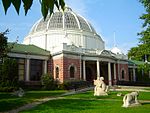Fort Rouillé

Fort Rouillé was a French trading post located in what is now Toronto, Ontario, Canada. Fort Rouillé was constructed by the French in 1751, building upon the success of a trading post they established in the area a year earlier, known as Fort Toronto. Fort Rouillé was named for Antoine Louis Rouillé, who at the time of its establishment was Secretary of State for the Navy in the administration of King Louis XV of France. It served as a trading post with the local indigenous peoples from the region. Fort Rouillé was evacuated and burnt down by its French garrison after the French defeat at Fort Niagara in July 1759, during the French and Indian War. The remains of the fort were demolished in the 19th century. The fort site is now part of the public lands of Exhibition Place. The location is marked by an obelisk monument, with the outline of the fort marked in concrete.
Excerpt from the Wikipedia article Fort Rouillé (License: CC BY-SA 3.0, Authors, Images).Fort Rouillé
Bridge 7, Toronto
Geographical coordinates (GPS) Address External links Nearby Places Show on map
Geographical coordinates (GPS)
| Latitude | Longitude |
|---|---|
| N 43.630619444444 ° | E -79.423555555556 ° |
Address
Fort Rouillé Monument
Bridge 7
M6K 1Y6 Toronto
Ontario, Canada
Open on Google Maps











